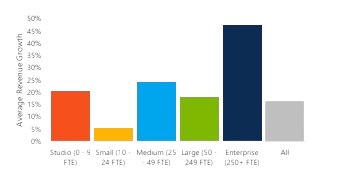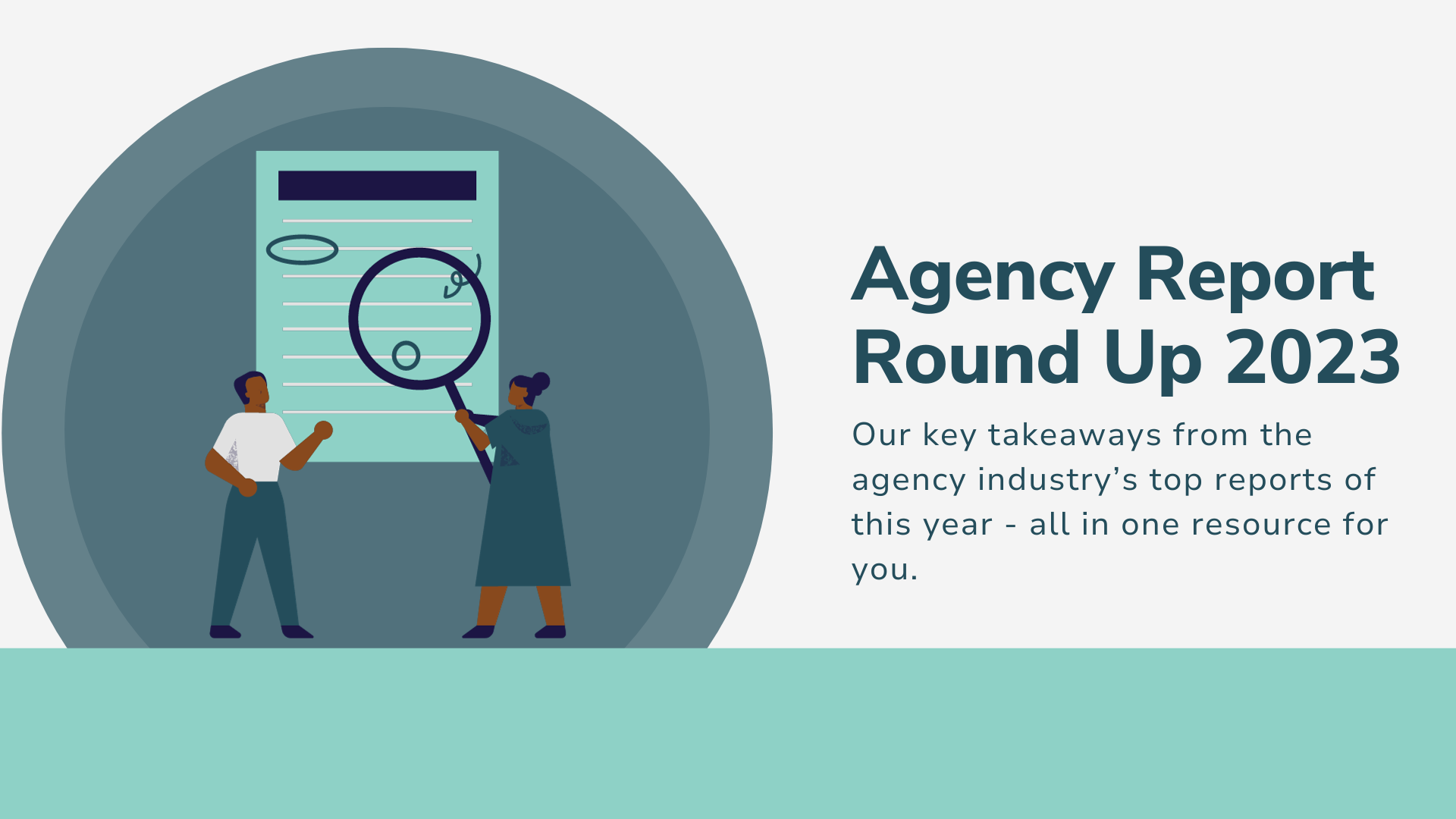Introduction
As we close out 2023, it felt like the right time to look back and review all of the industry reports published throughout the year. There are many to go through, with lots of insightful, but sometimes inconsistent findings.
To save you a bit of time and reading, we thought it would be valuable to publish our perspective on these reports and share our most important takeaways. Below you’ll find our overall lens on the state of the industry, along with our favorite reports published in 2023 and our key takeaways from each.
2023 in Review
There’s no doubt that 2023 has been a difficult year for agencies. Fear of an impending recession has clients moving work in-house, paring back budgets and/or hesitating to pull the trigger on spending. This has created increased competition for work, pushing agencies to either over-service clients or under-price in order to win work in the first place.
Meanwhile, inflation and increased competition for talent has driven up salaries. Turnover during this time has been high, which has further impacts on cost and efficiency. In response, many agencies have turned to freelancers and off-shore talent to help keep costs down.
On the other side of the ledger, most agencies have also increased prices in the past year. In most cases, however, the client pressures mentioned above have kept a lid on those increases. It seems like we just can’t catch a break here.
The good news? The general feel is that we’re around the bottom of things now and 2024 is looking more promising.
Let’s take a closer look at some of the key metrics we’re seeing in this year’s reports to better understand the larger trends:
Utilization Trends
It’s a bit tricky to find a baseline for target or actual utilization rates from the reports, since everyone measures it differently. Most reports don’t clearly define utilization, and even then they do, it’s hard to validate the inputs when each agency or individual has a different definition of concepts like a “billable hour”. That said, once we make adjustments to align to how Parakeeto measures it, it seems that a good *target* for an individual working solely in Delivery is around 70% (over the course of a year, with things like vacation time factored in)..
Actuals were much lower than that, though, pushed down by gaps in the sales pipeline and staff turnover (which means more onboarding and training time). It seems like actual utilization rates in 2022/23 were in the mid-50s.
Average Billable Rate (ABR) Trends
Most agencies aren’t actively measuring ABR, so we have to extrapolate from the reports a bit. There are two data points we can use:
First, standard rates are on the rise. Most agencies raised their rates at some point in the last year, albeit usually by less than 10%. We’re mostly seeing rates between $150-200 USD now, with a median somewhere around $175. (Note that this isn’t just for time & materials work; this rate is also the basis to arrive at flat project or retainer pricing.)
The second factor is drop-off rate: the difference between that standard rate and what
actually ends up getting billed to the client. Historically, drop-off rates range from 10-15%. Due to the over-servicing mentioned above, however, current rates are a bit higher: 20% is not unusual right now, with many projects going much further off the rails.
Combining those numbers, we can estimate that actual ABRs are more in the $120-160 USD range.
Pricing Model Trends
Data about pricing models was all over the map, really. Fixed price and time & materials models are still most common, with the majority of agencies using one or the other or both. Hourly models may be attractive at the moment in order to combat risks around over-servicing.
A smaller percentage of agencies are using value or performance-based pricing. There’s a lot of upside to these models, but success fluctuates with the market and we know how that’s been.
Profit Margin Trends
The combination of higher costs, lower Utilization, and over-servicing holding back ABRs is putting intense pressure on margins. The Bureau report linked below estimated net margins at 14% for the industry in 2022, down from 17% in 2021.
At Parakeeto, we like to see clients hitting at least 20% profit margin – ideally more. Clearly, we have some work to do to get back on track for 2024.
Want to go a bit deeper into the reports behind this info? Below are links to all of the reports we reviewed, along with some of the highlights and insights that stood out in each.
The 2023 SMB Marketing Report for Agencies by vCita
Key Highlights & Insights
- Unlike the other reports, this one is a survey of small-to-medium sized businesses (SMBs) as opposed to agencies. This is valuable insight for agencies looking to understand how this segment buys, what they look for, and why they leave.
- Worth noting is that over half of SMB’s expect their marketing budgets to grow in the next year and that 58% of SMB’s switched marketing providers in the last year (i.e. a high level of churn).
State of the Studio by Upsourced
Key Highlights & Insights
- This one walks through a really interesting approach to using leading indicator data (pipeline, profit, liquidity & layoffs) to understand where things are going next.
- Conclusion: starting in Q3, 2023, the worst is (hopefully) over and there are signs of recovery.

Side note: The simplest way to model capacity is often to create a “payroll grid”. This means listing all of your delivery and partial delivery employees, along with their weekly capacity and then multiplying that by the number of weeks in a given period.
Want to set benchmarks for your team and agency around utilization? You’d then add delivery/billable expectations and time off / holidays to that grid and model out your capacity and utilization targets for the team.
Example:

Agency Time Tracking Benchmarks Report by Toggl
Key Highlights & Insights
- Toggl provides insights gleaned from their customers’ time tracking data, accompanied by practical advice on topics like how to get better time tracking compliance and how to increase utilization rates.
- The most relevant data point for Parakeeto readers is that actual billable utilization in 2022 averaged 55% (down from 57% in 2021).

The State of Agency Operations by Teamwork
Key Highlights & Insights
- This is their first report, and it’s a good one, filled with great data and related resources for overcoming the issues mentioned in the report.
- It seems like utilization was at the center of many of those issues: agencies struggled with projecting utilization, with using time-tracking to improve utilization, and as a result, with hitting utilization rate targets (28% were at 25% or lower).

Digital Outlook 2023 by SoDA
Key Highlights & Insights
- This report covered both client-side and agency leaders, providing a look on both sides of the fence.
- At Parakeeto, we were especially interested to see the main priorities of each. Of note: 42% of agencies say improving operational efficiency is their top priority (their #1 issue), and 29% on the client-side said it was “leveraging data to make smarter/faster decisions” (#2 ranking).

Digital Agencies & AI by Promethean Research
Key Highlights & Insights
- Agencies are quickly adopting AI (mostly ChatGPT), especially for copywriting and development work.
- 42% of those have seen productivity improvements due to AI. Given the crunch reported in other reports, this is pretty important.

State of Digital Services 2023 by the Bureau of Digital
Key Highlights & Insights
- I’m a bit biased here, but I always love the Bureau’s annual industry report. It’s filled with lots of great data points, including some not found in other reports.
- This is where we got to hear about the growth rate (17% in 2022), how agencies achieved this growth (expanding service offerings: 41% growth rate), and team turnover (23% in 2022).

2023 Creative Industry Trends Report by FunctionPoint
Key Highlights & Insights
- As expected, there are some really interesting insights about utilization and time tracking in here. For example, 60% of teams are either under or over-worked, which directly impacts utilization and/or scheduling.
- And on the topic of time tracking, they found that only 67% of agencies are tracking time for all projects and that only 36% feel that this time tracking is accurate. Ouch.

Conclusion
There’s lots to learn from these industry reports, but you’ll notice that they each have different takes on things, sometimes resulting in conflicting guidance. What’s more important is how we apply this high-level data to our own agency and situation. Is our internal financial model providing the margins that we need for sustainable profit and growth? Are we pricing in a way that makes sense for our cost structure? Is our sales pipeline aligned with our capacity so as to hit utilization targets?
These are the kinds of questions we help answer at Parakeeto. Reach if you’d like to discuss how we can help you make 2024 your best yet.





0 Comments